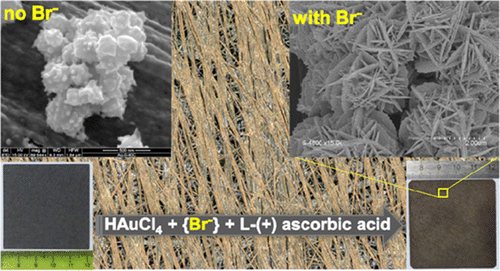当前位置:
X-MOL 学术
›
ACS Appl. Energy Mater.
›
论文详情
Our official English website, www.x-mol.net, welcomes your
feedback! (Note: you will need to create a separate account there.)
Bromide-Regulated Anisotropic Growth of Desert-Rose-Like Nanostructured Gold onto Carbon Fiber Electrodes as Freestanding Electrocatalysts
ACS Applied Energy Materials ( IF 5.4 ) Pub Date : 2020-07-08 00:00:00 , DOI: 10.1021/acsaem.0c01008 Paul Morandi 1 , Nazym Tuleushova 1 , Sophie Tingry 1 , Julien Cambedouzou 1 , Shelley D. Minteer 2 , David Cornu 1 , Yaovi Holade 1
ACS Applied Energy Materials ( IF 5.4 ) Pub Date : 2020-07-08 00:00:00 , DOI: 10.1021/acsaem.0c01008 Paul Morandi 1 , Nazym Tuleushova 1 , Sophie Tingry 1 , Julien Cambedouzou 1 , Shelley D. Minteer 2 , David Cornu 1 , Yaovi Holade 1
Affiliation

|
Three-dimensional (3D) gas-diffusion electrodes (GDEs) as support for catalytic nanoparticles are important to the electrolysis and fuel cell fields to facilitate reactant transport and distribution and reach higher current densities. Hence, the assembly of nanostructured catalytic particles directly onto GDEs during the synthesis could be a powerful one-step strategy to target high performance and long-term durability thanks to the induced strong nanoparticle–support interaction. We report herein the use of bromide anions to shape the anisotropic growth of nanostructured desert-rose-like gold particles directly onto the GDE, as a freestanding GDE–Au catalyst for straightforward use in electrolysis without an additional step. We showed that the bromide ions determine the anisotropy of the particles, resulting in the growth of gold into nanoplates enclosed by (111) facets. The formation of hierarchical nanostructured three-dimensional (3D) Au at the GDE surface was explained by the nanoparticle-mediated aggregation mechanism and the preferential adsorption of Br– on the (111) facet, leaving behind dominant planar structured nuclei, which then self-assemble. Electrocatalytic tests toward the glycerol electro-oxidation demonstrated that the as-synthesized freestanding surfactant- and binder-free GDE–Au material (100 μgAu cm–2) delivered a high specific peak current density of jp = 33 mA cmAu–2, which is three and seven times higher than the tested commercial Au/C nanocatalyst at loadings of 76 and 152 μgAu cm–2, respectively. This study provides future directions for the synthesis and application of nanostructured catalysts for alcohol oxidation as an alternative to anodic oxygen evolution, which consumes the majority of the electricity input during the electrolysis.
中文翻译:

溴化物调控的沙漠玫瑰状纳米结构金在碳纤维电极上的独立生长作为独立的电催化剂
用作催化纳米颗粒的三维(3D)气体扩散电极(GDE)对于电解和燃料电池领域至关重要,以促进反应物的运输和分配并达到更高的电流密度。因此,由于诱导了强烈的纳米颗粒与载体的相互作用,在合成过程中将纳米结构催化颗粒直接组装到GDE上可能是一种针对高性能和长期耐久性的强大一步策略。我们在此报告了使用溴化物阴离子将纳米结构的沙漠玫瑰状金颗粒的各向异性生长直接形成到GDE上,作为一种独立的GDE-Au催化剂,可直接用于电解而无需额外的步骤。我们表明,溴离子决定了粒子的各向异性,导致金生长为被(111)面包围的纳米板。纳米粒子介导的聚集机理和对溴的优先吸附解释了在GDE表面上分层的纳米结构三维(3D)金的形成。–在(111)小平面上,留下主要的平面结构核,然后进行自组装。对甘油电氧化的电催化测试表明,合成后的无表面活性剂和无粘结剂的GDE-Au材料(100μgAu cm –2)可以提供较高的比峰电流密度j p = 33 mA cm Au –2在76和152μgAu cm –2的负载量下,这是测试的商用Au / C纳米催化剂的三到七倍, 分别。这项研究为乙醇氧化的纳米结构催化剂的合成和应用提供了未来的方向,该催化剂可替代阳极氧的生成,而阳极氧的消耗在电解过程中消耗了大部分电力。
更新日期:2020-07-08
中文翻译:

溴化物调控的沙漠玫瑰状纳米结构金在碳纤维电极上的独立生长作为独立的电催化剂
用作催化纳米颗粒的三维(3D)气体扩散电极(GDE)对于电解和燃料电池领域至关重要,以促进反应物的运输和分配并达到更高的电流密度。因此,由于诱导了强烈的纳米颗粒与载体的相互作用,在合成过程中将纳米结构催化颗粒直接组装到GDE上可能是一种针对高性能和长期耐久性的强大一步策略。我们在此报告了使用溴化物阴离子将纳米结构的沙漠玫瑰状金颗粒的各向异性生长直接形成到GDE上,作为一种独立的GDE-Au催化剂,可直接用于电解而无需额外的步骤。我们表明,溴离子决定了粒子的各向异性,导致金生长为被(111)面包围的纳米板。纳米粒子介导的聚集机理和对溴的优先吸附解释了在GDE表面上分层的纳米结构三维(3D)金的形成。–在(111)小平面上,留下主要的平面结构核,然后进行自组装。对甘油电氧化的电催化测试表明,合成后的无表面活性剂和无粘结剂的GDE-Au材料(100μgAu cm –2)可以提供较高的比峰电流密度j p = 33 mA cm Au –2在76和152μgAu cm –2的负载量下,这是测试的商用Au / C纳米催化剂的三到七倍, 分别。这项研究为乙醇氧化的纳米结构催化剂的合成和应用提供了未来的方向,该催化剂可替代阳极氧的生成,而阳极氧的消耗在电解过程中消耗了大部分电力。











































 京公网安备 11010802027423号
京公网安备 11010802027423号